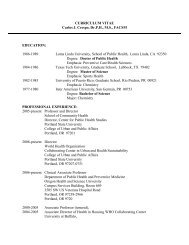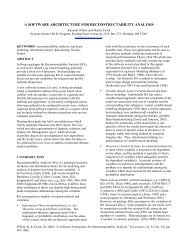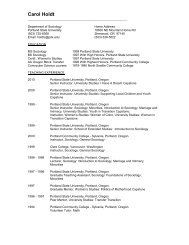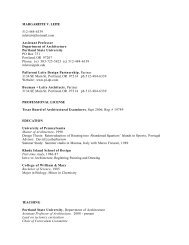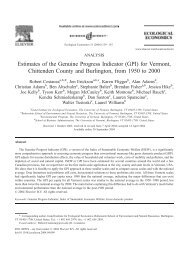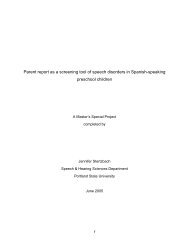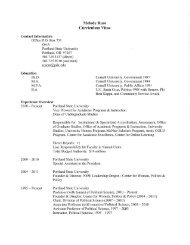Effects of integral stimulation therapy on speech - Portland State ...
Effects of integral stimulation therapy on speech - Portland State ...
Effects of integral stimulation therapy on speech - Portland State ...
You also want an ePaper? Increase the reach of your titles
YUMPU automatically turns print PDFs into web optimized ePapers that Google loves.
Data Results for Interdental Fricatives: /θ / and /ð /<br />
Figure 4 illustrates CP’s performance during <strong>speech</strong> probes as the percent <str<strong>on</strong>g>of</str<strong>on</strong>g><br />
interdental fricatives /θ/ and /ð/ correctly produced. Data were charted over time during<br />
baseline, treatment, and post treatment phases. Pre treatment data probes indicated that<br />
CP made a variety <str<strong>on</strong>g>of</str<strong>on</strong>g> substituti<strong>on</strong> errors and omissi<strong>on</strong>s when attempting interdental<br />
fricative sounds. Most notable was his tendency to substitute bilabial fricatives /Ȉ/ and<br />
/β/ in place <str<strong>on</strong>g>of</str<strong>on</strong>g> /θ/ and /ð/ ph<strong>on</strong>emes in the majority <str<strong>on</strong>g>of</str<strong>on</strong>g> substituti<strong>on</strong> errors. This pattern<br />
was also observed in his attempts to approximate interdental sounds /f/ and /v/. CP<br />
substituted /v/, /d/, /z/, and /f/ sounds in initial word positi<strong>on</strong>s and /f/ in final positi<strong>on</strong>s.<br />
CP dem<strong>on</strong>strated c<strong>on</strong>sistent levels <str<strong>on</strong>g>of</str<strong>on</strong>g> performance (0% correct) <strong>on</strong> <strong>speech</strong> probes during<br />
baseline sessi<strong>on</strong>s (22 through 26). Sessi<strong>on</strong>s 27 through 37 include data probes gathered<br />
after treatment had begun and before the post treatment period. Data gathered over 12<br />
treatment sessi<strong>on</strong>s show CP resp<strong>on</strong>ding to treatment with variable results. Accuracy <str<strong>on</strong>g>of</str<strong>on</strong>g> /θ/<br />
and /ð/ ph<strong>on</strong>emes ranged from 0 to 60% correct. Despite a short treatment period and<br />
fluctuating performance, CP’s accuracy showed a pattern <str<strong>on</strong>g>of</str<strong>on</strong>g> increased improvement over<br />
the course <str<strong>on</strong>g>of</str<strong>on</strong>g> the treatment. His baseline accuracy for interdental fricatives was<br />
c<strong>on</strong>sistently at 0%. After 4 treatment sessi<strong>on</strong>s, his performance increased, but then<br />
decreased following 3 cancelled sessi<strong>on</strong>s due to illness. CP c<strong>on</strong>tinued to show symptoms<br />
<str<strong>on</strong>g>of</str<strong>on</strong>g> c<strong>on</strong>gesti<strong>on</strong> even after he returned to <strong>speech</strong> <str<strong>on</strong>g>therapy</str<strong>on</strong>g>.<br />
60



